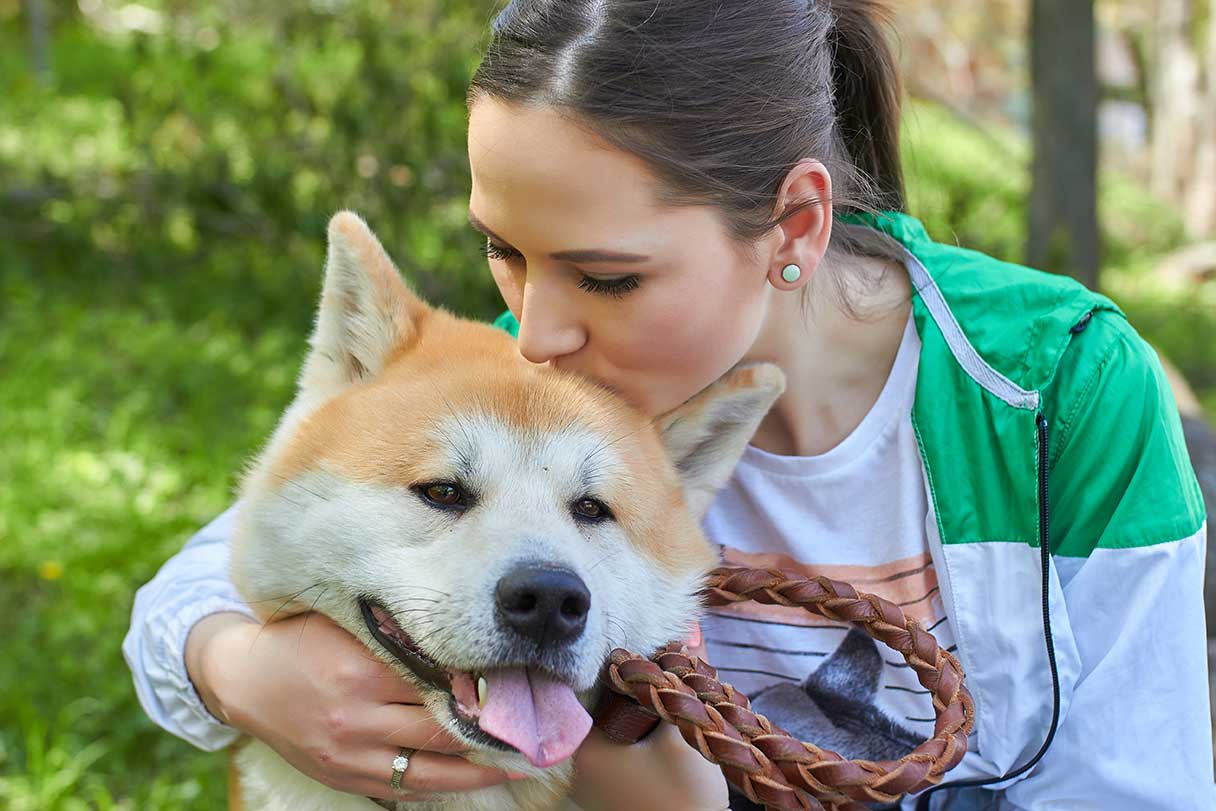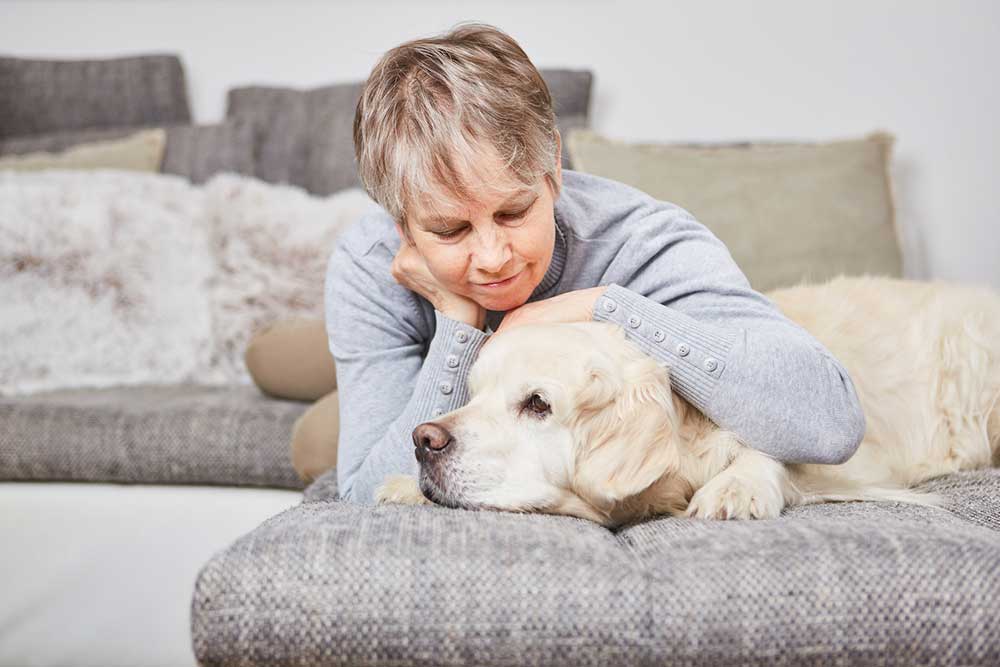Dogs tend to get all kinds of lumps and bumps, especially as they get older, but it can be alarming to discover anything that looks like it could be a tumor on your best furry pal. The good news is that not all lumps are serious. A smooth, round bump that feels like it's full of fat is most likely a lipoma, which is common with aging pups. Learn more about lipoma in dogs and what to do if you find any on your pooch.
What Is a Lipoma?
A lipoma is a noncancerous fatty tumor filled with soft tissue that's extremely common in middle-aged and senior dogs, although it can appear in younger dogs as well.
The tumors are filled with fat cells that usually appear just beneath the skin. However, they can also develop internally. Lipomas on dogs generally have a soft and smooth texture and are rounded in appearance. They can range in size from smaller than a walnut to the size of a softball.1
Types of lipomas
There are three common types of lipomas that typically affect dogs:2
- Simple lipoma is the most common type of dog lipoma. These benign fatty tumors usually form in the fatty tissue layer just beneath the skin. They most often develop on the legs, in the armpits and on the chest and abdomen,3 although they can also grow on internal organs and in the lining of the stomach.4
- Infiltrative lipoma, while still benign, can invade the surrounding tissue. This type of lipoma can appear between the muscle layers.1
- Myelolipoma is not pure fatty tissue, but includes hematopoietic cells — the cells that produce red and white blood cells. This is an internal lipoma that occurs on the spleen, liver or adrenal glands.2
True lipomas aren't life-threatening, although depending on their size and location they can cause your dog a lot of pain and discomfort and affect mobility. Lipomas located on the heart or internal organs can also cause organ dysfunction and other complications.4
Lipoma vs. liposarcoma
While not true lipoma, liposarcomas are cancerous fatty tumors that closely resemble lipomas. They don't develop from existing lipomas. They typically don't spread through the body, although they can metastasize in rare cases,1 and they can usually be surgically removed. The prognosis of a liposarcoma is generally considered fair, with most dogs living two to three years past surgery.4
Lipoma vs. lymphoma
Although they sound similar, lipoma shouldn't be confused with lymphoma, which is a cancerous tumor that develops in a dog's lymph nodes.5
Lipoma vs. cysts
Appearance-wise, lipomas can also be confused with cysts, which are membranes that fill with fluid secreted by the body or solid material like keratin or dead skin cells.6
Lipoma vs. abscesses
Lipomas can also appear similar to abscesses, which are swollen pockets of pus that form when a wound or gland becomes infected.7
Because lipomas can be similar in appearance to cancerous tumors and other issues that require veterinary treatment, you should always have your vet check them out and provide an official diagnosis.
What Causes Lipoma in Dogs?
No one knows for sure what causes lipomas to develop in dogs. Whatever causes fatty tumors in dogs, advanced age and being overweight appear to be the primary risk factors.4
Lipomas occur most often in middle-aged and senior dogs,1 and frequently occur in overweight females.3 Certain dog breeds are more susceptible to lipoma, including Labradors, Doberman pinschers, mini schnauzers, cocker spaniels, dachshunds, poodles and terriers, which suggests there may be a genetic component.3
It's also thought that lipomas can be caused by physical trauma.1 Other causes of lipoma in dogs may include:1
- Exposure to chemicals. Chemicals in tap water and in the environment can disrupt proper function of the thyroid gland and the endocrine system, which can in turn interfere with the body's ability to excrete potential toxins through the skin, causing fatty tumors to appear.
- Poor diet. Besides dogs being overfed and overweight, a poor diet filled with excess carbohydrates and chemical preservatives found in processed dog food might contribute to the development of lipomas.
Symptoms of Dog Lipoma
A lipoma appears as a soft, round or oval lump that should be slightly moveable. Your dog shouldn't show any signs of pain if you touch it or lightly press on it. Additional symptoms, if any, will depend on where it's located:2
| Lipoma Location | Common Symptoms |
|---|---|
|
Chest |
Shallow or accelerated breathing, coughing |
|
Spleen |
Pale gums, distended abdomen, labored breathing and possible collapse |
|
Between muscles |
Soreness and stiffness, or a hard time moving the limb containing the lipoma |
|
Nervous system |
Muscle twitching or tremors, lack of coordination, unusual head tilt, circling, dizziness, disorientation, seizures and weakness or paralysis in the hind quarters8 |
Also, a rapidly growing lipoma can outpace the blood supply and become necrotic and infected, leading to symptoms that include inflammation, swelling and pain.2
How Are Lipomas in Dogs Diagnosed?
Lipomas are diagnosed by a simple form of biopsy called fine needle aspiration (FNA), in which a veterinarian inserts a thin needle into the growth to remove a cell sample. This sample is then examined under a microscope to see if the growth contains any type of cells other than fat cells.2
If FNA is inconclusive, a more comprehensive biopsy may be required. This is a more invasive diagnostic procedure that involves partial or complete removal of the mass while your dog is under anesthesia.4
An ultrasound or X-ray may be necessary to detect an internal lipoma, and also to determine its size and whether the vet can access it for FNA or biopsy.2
Read Related: How Much Is a Vet Visit for a Dog?
Dog Lipoma Treatment Options
Not all lipomas require treatment. As long as the lipoma is slow-growing, it's not affecting your dog's quality of life and there are no other symptoms present, your vet may simply advise you to keep an eye on it and report any changes that might indicate complications.3
Surgical removal
For a lipoma that's hampering your pup's quality of life or causing health complications, surgical removal may be required. Your vet might be able to remove a simple lipoma using only a local anesthetic and sedation, but for larger or harder-to-get-to lipomas, general anesthesia will be necessary.3 Your vet might first inject the fatty tumor with a calcium chloride solution or an anti-inflammatory drug in order to shrink the mass prior to removal.4 Radiation therapy might also be needed to either prevent lipomas from showing up again or slow down their future development.3
Liposuction
For lipomas that are easily accessible, liposuction — the removal of fat via vacuum suction — might be a viable alternative to surgical removal. While still a surgical procedure that may require some type of anesthesia, liposuction tends to be less invasive and offers faster healing.3
How Much Does It Cost to Remove Dog Lipoma?
Uncomplicated lipoma removal procedures typically cost less than $500. The larger the lipoma or the harder it is to get to, the more costly the surgery will be, with some lipoma removal surgeries costing more than $1,000.4
Depending on how many sessions are needed, radiation therapy can cost anywhere from $750 to $7,500 or more, with most treatments ranging between $2,000 and $6,000.9
How to Shrink a Dog Lipoma Naturally
Weight loss has been reported to shrink lipomas on overweight dogs. Whether weight loss causes your dog's lipomas to shrink or not, being overweight is a risk factor for developing lipomas, so getting your pup to a healthy weight may prevent additional lipomas from developing.3
Some anti-inflammatory herbs and supplements have also been anecdotally reported to shrink fatty tumors in dogs, including:
- CBD oil4
- Turmeric3
- Curcumin (the active compound in turmeric)3
Talk to your vet or consult a holistic vet about the proper dosage and to make sure it's safe to give any supplements to your dog, especially if they're pregnant, lactating or taking any medication.
Additionally, although there have been no scientific studies, some pet parents have reported lipomas disappearing after switching their dogs to a raw, grain-free diet.3
Can Lipomas Be Prevented?
No preventive measure is guaranteed to keep your dog from developing fatty tumors. That said, maintaining them at a healthy weight and feeding them high-quality dog food that's high in nutritional value and lacks fillers, chemicals and artificial ingredients can reduce your pet's chances of developing lipomas.4
Frequently Asked Questions About Dog Lipoma
Living With Lipoma
Lipomas aren't cancerous or life-threatening. They can impact your dog's health and make life difficult for them, but that isn't always the case. In any event, any unusual bumps, lumps or masses you find on your dog should be examined and diagnosed by a vet to rule out cancer and determine whether another health issue needs to be dealt with. But lipomas are a treatable condition, and dogs with lipomas and no other health issues typically live long and happy lives.
Financing Dog Lipoma Removal With the CareCredit Credit Card
Your dog is your best friend, and you want to make sure they get the very best. That's why the CareCredit credit card is here to help you manage the costs of diagnostics and treatment for conditions like lipomas.* Apply today and use our Acceptance Locator to find a veterinarian near you that accepts CareCredit. CareCredit is there for you and your pet every step of the way; continue your wellness journey by downloading the CareCredit Mobile App to manage your account, find a provider on the go and easily access the Well U hub for more great articles, podcasts and videos.
Author Bio
Jean Marie Bauhaus is a freelance writer and novelist with eight years of experience. Her work has appeared on Hill's Pet, Chewy and AKC.org and more.







